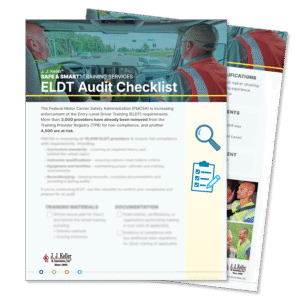In 1980, there were about 18,000 motor carriers in the U.S. The Motor Carrier Act of 1980 removed the cumbersome process of becoming a motor carrier.
It was the beginning of what P. Sean Garney, co-director of Scopelitis Transportation Consulting, describes as “the rise of the small carrier.” By 1986, more than 200,000 carriers were operating. As of 2025, that number has grown to over 466,000 for-hire carriers, plus another 175,000 private carriers.
Determining which of those carriers should be targeted for regulatory intervention is a daunting task.
The Federal Motor Carrier Safety Administration (FMCSA) hopes that upcoming changes to its Compliance, Safety and Accountability (CSA) program will help the agency zero in on carriers that present a safety risk while providing clearer insight to all carriers about how they compare to others.
The FMCSA implemented the CSA program in 2010. As modernization of computerized information systems was making sharing of trucking industry data faster and more universal, CSA used data taken from crash reports, vehicle and driver inspections, and carrier audits to identify high-risk carriers.
Why change CSA?
From the beginning, carriers complained about the way safety scores were calculated, questioning whether scores really related to crash risk. After all, insurance rates, customer decisions and driver employment decisions are all impacted by CSA scores, so carriers can be negatively impacted by their scores even without FMCSA intervention.
The Fixing America’s Surface Transportation (FAST) Act, signed into law in December 2015, required a comprehensive study of the CSA program’s Safety Measurement System (SMS), conducted by the National Academies of Sciences, Engineering and Medicine. The Act directed that CSA scores not be publicized until revisions were made. The proposed CSA program revision is the agency’s response.
Say bye-bye to the ‘BASICs’
One of the most noticeable of the FMCSA’s proposed changes is the elimination of the seven familiar BASICs (Behavioral Analysis and Safety Improvement Categories). They will be replaced with six “Compliance Categories.” The current “Controlled Substance and Alcohol” BASIC will now be a part of the “Unsafe Driving” category, as will all Out of Service (OOS) violations.
The Vehicle Maintenance category will see changes as well. The 410 potential violations listed under the category will be divided into two groups, with 312 of them (78%) listed in the “Vehicle Maintenance: Driver Observed” subcategory. These violations are generally those that the driver could identify during a pre- or post-trip inspection, without crawling under the truck.
“This will require carriers to double down on the DVIR (Driver-Vehicle Inspection Report) process, and that’s sometimes difficult to impose on drivers,” Garney noted.
A list of Compliance Categories and the violations listed under each is available as an automatic download here.
Violation severity ratings
Perhaps of greater interest to many carriers are proposed changes in violation severity ratings. Currently they’re rated on a scale of 1-10, with more serious violations earning higher scores. According to Garney, some of those scores seem arbitrary.
“A seat belt violation is a seven?” he asked. “Some carriers might wonder how a driver not wearing a seat belt increases their risk of a crash.”
Under the revised CSA, violations will be assigned one point each — with the exception of violations that result in the driver being placed out of service (OOS). Those more serious violations will be assigned two points.
“This could impact fleets that have a pattern of committing minor violations and how they compare to fleets that commit more severe ones (albeit less frequently),” explained Rob Abbott, vice president at Fleetworthy Solutions.
Additionally, carriers currently receive points for violations that occurred in the past two years. Under the proposed program, the violation must have occurred within the preceding 12 months, with the exception of violations in the Unsafe Driving and Crash categories, which will continue to have a longer history tracked.
“This is a small victory for fleets that have deliberately addressed their prior deficiencies and improved their performance from the previous year,” Abbott said.
Violation ‘grouping’
Another change that could benefit carriers is the grouping of similar violations. Multiple violations in one category will be assigned one total point, rather than scored individually. The current 973 violations will be consolidated into 116 violation groups.
In a January webinar hosted by FMCSA, Wesley Russell from the agency’s Compliance Division used the example of a driver who receives violations for the 14-hour rule, the 11-hour rule, a rest break and a 70-hour rule.
“If all of those are in the same group, we’re going to issue only one point — even if the inspection has all of those on it,” he explained.
More changes
The way carriers are categorized by type will change as well, with clearer differentiation between carriers that primarily operate straight trucks and those that run combination vehicles.
The miles cap for the Unsafe Driving and Crash categories will move to 250,000 miles, and intervention thresholds are changing too. The threshold for general freight carriers — currently 80% — will rise to 90%, with hazmat carriers rising from 75% to 85%.
However, Garney cautions, “data quality and sufficiency is the key to accuracy, so carriers should remain vigilant.”
When will all this happen?
While the FMCSA has released information about what’s in the revised CSA program, when it will take effect is still in question. Scheduled agency webinars in March and April were cancelled.
In addition, on March 21 Adrienne Camire, the FMCSA’s previously announced acting administrator, was abruptly removed from the agency website. On March 24, President Donald Trump nominated Derek Barrs for the spot.
Once the FMCSA’s leadership is settled, perhaps the agency will move forward on the final ruling, which is expected to contain few changes from the information already issued.
Phase 3 of the process will include the new methodology and a revised website, and the final ruling will allow a time period until implementation.
“As with all changes to the scoring system, there will be some winners and losers — especially when you consider that the scores reflect comparative performance,” Abbott acknowledged. “But, for the most part, these adjustments will address some common objections and subdue some criticisms of the program.”
For a complete overview of proposed changes to the CSA, click here.
This story originally appeared in the July/August 2025 print edition of Truckload Authority, the official publication of the Truckload Carriers Association.
Cliff Abbott is an experienced commercial vehicle driver and owner-operator who still holds a CDL in his home state of Alabama. In nearly 40 years in trucking, he’s been an instructor and trainer and has managed safety and recruiting operations for several carriers. Having never lost his love of the road, Cliff has written a book and hundreds of songs and has been writing for The Trucker for more than a decade.














